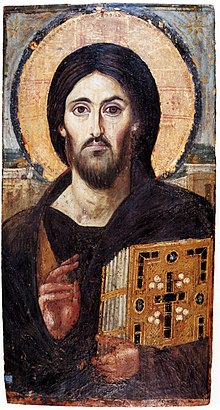Pantocrator

Pantokrator (Greek παντοκράτωρ , German also Pankrator ) means ruler of all or worlds.
origin
The word appears around 120 times in the Septuagint . In the Greek Book of Job , Pantocrator regularly serves as a translation for the divine designation Schaddai , e.g. B. Job 11.7 ZB.EU . In the Greek books of Jeremiah and the Twelve Prophets, on the other hand, Pantocrator regularly stands for the epithet Zebaot attached to YHWH (Kyrios) , e.g. B. At 4.13 EU . This is reproduced in other books and in more recent Greek translations but also in transcription ( Σαβαωθ Sabaoth , as in the Book of Isaiah, e.g. Isa 6,3 EU ) or translated as (Lord of the) Armies ( των δυναμεων tōn dynámeōn , as in the Psalter , e.g. Ps 46.8 EU ).
In the New Testament , the term Pantocrator occurs once in 2 Corinthians and nine times in the Revelation of John , always referring to God the Father . The transfer of the title to the son , which had already been factually prepared in, among other things, Matthew 28:18 EU , only happened expressly in the course of the 4th century against the background of christological controversies; the veneration of Jesus Christ as Pantocrator was intended to emphasize his perfect divine nature , as especially Athanasius of Alexandria taught.
iconography
Today, Christ Pantocrator is usually a type of iconography . The motif is found above all in Byzantine art and in the vast majority of Greek Orthodox and Russian Orthodox churches . Most of the time, the icon of Christ is located in the vault of the apse or in the center of the iconostasis . Usually the pantocrator is depicted as a bust, but there are also enthroned or standing full-body depictions. Typical are the head that is looking at the viewer, the nimbus of the cross , the posture of the right hand that blesses the viewer, and a closed or open Gospel book in the left, in which Christ's self-statements ("I am ..." words) are often made to read the Gospels. The undergarment (chiton) is red, the overgarment (himation) is usually blue or rarely green. The pantocrator type emphasizes Christ's equality with God, his world domination, power of blessing and teaching authority.
There is a very rare encaustic icon of Christ Pantocrator from the 6th century in St. Catherine's Monastery . Jesus, represented as ruler, holds the New Testament. For a long time the work, which probably came from Constantinople, was dated to the 13th century because it was almost completely painted over. The icon is 84 × 45.5 centimeters. For the design of the face, the artist based himself on the Semitic face type with a beard and long hair.

See also
Web links
Individual evidence
- ↑ Lexicon for Theology and Church . Vol. 7, [edition?], Herder, Freiburg i. Br., Sp. 1320.
- ↑ 2 Cor 6,18 EU , taking up from 2 Sam 7,8.14 EU .
- ↑ Rev 1.8 EU , 4.8 EU , 11.17 EU , 15.3 EU , 16.7.14 EU , 19.6.15 EU , 21.22 EU , often in quotations or allusions to Old Testament texts in which Zebaot is written , see. Rev 4,8 with Isa 6,3.
- ^ Rainer Warland: Pantokrator. II. Historical-theological. In: Walter Kasper (Ed.): Lexicon for Theology and Church . 3. Edition. tape 7 . Herder, Freiburg im Breisgau 1998, Sp. 1320 .
- ↑ K. Onasch / A. Schnieper, Ikonen, Munich 2007, p. 122f.
- ↑ A. Tradigo, Icons and Sints of the Eastern Orthodox Church, Los Angeles 2006, p 244
